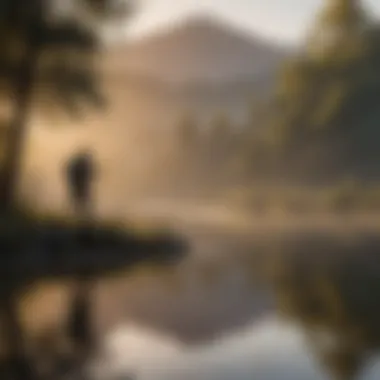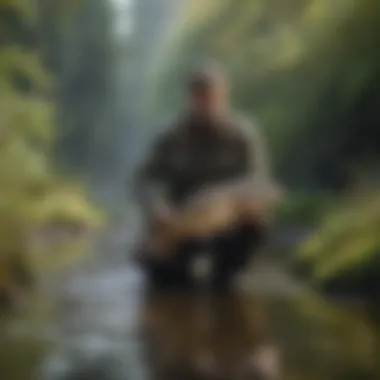Optimal Fishing Hours: Unlocking the Secrets of Timing


Intro
Fishing is not just a hobby for many; it is a way to connect with nature, a test of patience, and a challenge that offers rewards for those who understand the rhythms of aquatic life. Knowing the right time to fish is crucial for increasing catch rates. Many factors influence fish behavior, including lunar cycles, seasonal changes, and weather conditions.
Understanding the optimal hours when fish are most likely to be active allows anglers to plan their trips more effectively. Timing is essential; even a few hours can significantly impact success. This article dives deep into the science of fishing hours, providing valuable insights for individuals aiming to maximize their fishing experience.
Animal Species Profile
Preface to the animal species
When discussing fishing, various fish species come into play. Each species has unique characteristics that influence when they are most active. For example, species such as trout, bass, and catfish are affected by different environmental factors, which define their feeding patterns and peak activity times.
Physical characteristics and appearance
Trout are known for their vibrant colors and speckled skin, while bass tend to have a greenish hue with a larger body. Catfish, on the other hand, possess a distinctive whisker-like structure known as barbels, aiding in their olfactory navigation.
Natural habitat and distribution
Fish inhabit a variety of environments. Trout are often found in cold, clear streams and lakes, while bass prefer warmer waters. Catfish dwell in lakes, rivers, and brackish waters. Local distribution of these species often reflects their adaptive traits and environmental preferences.
Behavior and social interactions
Fish behavior varies significantly. For instance, trout can be solitary, while bass may often be found in schools. Understanding these behaviors helps anglers predict the best times to fish for each species, enhancing the chances of success on the water.
Factors Affecting Fishing Hours
Lunar phases
The lunar cycle has a great influence on fish behavior. Fish tend to feed more actively during full moons and new moons. This is largely due to the increase in light, which can impact their feeding patterns.
Weather conditions
Different weather conditions also play a pivotal role. Overcast days can result in higher fish activity due to decreased light penetration, while sunny days might see fish retreat to cooler, deeper waters.
Seasonal variations
Seasons significantly affect how fish behave. In spring, many fish are preparing to spawn, leading to increased feeding activity. Summers are typically slower during hot days but can be productive during early mornings or late evenings.
"Understanding the intricate behaviors of fish can lead to more successful fishing trips. It is not mere luck but knowledge of nature that holds the key."
The End
The opportunity for a successful catch lies within understanding the behaviors of fish species, lunar phases, weather, and seasonal changes. By carefully considering these aspects, anglers can enhance their fishing experience. Fishing requires patience and skill, but it begins with timing, and this article aims to equip readers with a comprehensive understanding to refine their fishing trips.
Preamble to Fishing Timing
Fishing is not just a matter of dropping a line and hoping for the best. Understanding the timing of fishing significantly impacts one's success on the water. Aspects such as lunar phases, weather conditions, and seasonal changes all play a crucial role in determining when fish are most active. This section will discuss how these elements intertwine to form a comprehensive strategy for avid anglers.
Timing in fishing is essential because fish have specific periods of activity. These patterns can often correlate with the times when anglers are out fishing. Therefore, grasping this relationship helps in planning trips effectively. Knowing when fish are likely to bite not only increases the chances of a good catch but also enhances the overall experience of fishing.
There are several benefits to studying fishing timing. First, it can save time. Instead of spending hours with little success, discerning the best times to fish allows for more efficient trips. Second, it enables anglers to maximize their potential catch. More bites can translate into more fish on the line, which is the ultimate goal for many.
However, timing is not the only factor at play in fishing success. It is vital to consider various other elements that influence fish behavior. The subsequent sections will discuss these factors in detail, providing a clearer picture of how to optimize fishing hours and strategies.
Lunar Influence on Fishing Hours
The impact of lunar phases on fishing hours is a topic that resonates deeply with avid anglers. The moon plays a crucial role in influencing tidal patterns and aquatic ecosystems, which in turn affect fish behavior. Understanding these lunar cycles can greatly enhance a fisherman's ability to time their trips effectively. This knowledge allows for a more strategic approach to fishing, leading to improved catch rates and overall satisfaction.


Understanding Lunar Cycles
Lunar cycles consist of phases that repeat approximately every 29.5 days. These cycles shift from the new moon to full moon and back again, each phase having its own unique impacts on fish activity. During the new moon and full moon, there is typically a stronger gravitational pull that affects tides, resulting in higher tidal movements. This increased activity can lead to better fishing opportunities, as fish tend to be more active during these times.
Moreover, fish species often exhibit different behaviors depending on the moon's position. For instance, many predatory fish are more likely to hunt during the brighter nights associated with full moons. In contrast, some species may prefer the cover of darkness present during the new moon phase. By observing these patterns, anglers can make informed decisions about when to head out in pursuit of their catch.
Key Points about Lunar Cycles:
- The moon's gravitational pull influences water levels and tides.
- Fish behavior may change dramatically between new and full moons.
- Timing fishing trips according to lunar phases can yield better results.
Best Days to Fish According to the Moon Phase
Selecting optimal fishing days according to the moon phase is essential for any angler aiming to maximize their catch. Generally, the days surrounding the new moon and full moon are widely regarded as the best times for fishing.
During the full moon phase, it's beneficial to target fish that are active at night. Fish often utilize the increased light for feeding, making late evening or nighttime conditions ideal. Conversely, fishing around the new moon could be advantageous during daylight hours, as fish are compelled to forage more actively in response to the darker conditions.
Recommended Fishing Days by Lunar Phase:
- New Moon: Best for afternoon and evening fishing.
- Waxing Crescent: Increased activity before the moon reaches its full phase.
- Full Moon: Optimal for night fishing with significant visibility.
- Waning Crescent: Fish may be less active, though some species will still feed.
Understanding the nuances of lunar influence allows anglers to tailor their strategies and increase their chances of a fruitful fishing trip.
By making conscious decisions based on lunar influences, fishermen can enhance their experiences on the water. Tracking lunar phases and aligning fishing trips accordingly is a simple yet effective way to increase success rates. With this knowledge in hand, anglers should feel confident in their ability to navigate optimal fishing hours with greater ease.
Weather Conditions and Their Impact
Understanding weather conditions is essential for successful fishing. Weather affects not just the comfort of the angler but more importantly, the behavior of fish. Temperature, precipitation, and wind patterns interact in complex ways that directly influence fish activity. This section outlines how these weather elements can determine the best fishing hours and conditions.
Temperature and Fish Behavior
Temperature plays a critical role in the seasonal and daily behavior of fish. Fish are ectothermic animals, meaning their body temperature adjusts to the surrounding environment. As water temperatures rise, fish typically become more active. They tend to feed more aggressively, especially during warmer months.
Cooler temperatures can reduce fish activity, leading to less feeding. It's important to note specific temperatures that different species prefer. For example, bass often thrive in warmer waters, while trout are more active in cooler environments.
- Optimal Temperature Ranges:
- Bass: 65°F to 80°F
- Trout: 50°F to 65°F
An angler should keep track of local water temperatures both seasonally and prior to a fishing trip. Using a reliable thermometer can be helpful to measure water conditions accurately.
Precipitation Effects on Fishing
Precipitation influences fishing in various ways. Rain can alter water levels and clarity, affecting fish behavior. When it rains, fish may become more active, especially in freshwater. The disturbance can stimulate feeding, as insects and other organisms are washed into the water.
However, heavy rainfall can lead to lower visibility, making fishing more challenging. Fish might also retreat to calmer areas where the water is less turbulent. Consider these factors during rain:
- Moderate Rain: Often improves fishing as it brings food to the surface.
- Heavy Rain: Can cloud water and push fish into deeper, quieter zones.
Anglers should assess the situation and adjust their techniques accordingly. Choosing lures that mimic distressed prey can be effective on rainy days.
Wind and Tides: A Complex Relationship
Wind affects fishing in both positive and negative ways. It can create surface disturbances, leading to better feeding conditions for fish. Additionally, wind can move warmer or cooler water, impacting local temperatures and fish behavior.
- Benefits of Wind:
- Creates waves that hide an angler's approach.
- Displaces food sources, triggering feeding frenzies.
On the other hand, strong winds can pose challenges, creating difficult casting conditions. Light winds are often preferred for clearer days, while stronger winds might help stir up food.


Tides also interact with wind, especially in coastal areas. High tides may bring fish into shallow waters, while low tides often push them back out. Understanding the tides can enhance trip planning significantly:
- High Tide: Better opportunities for shallow water fishing.
- Low Tide: Fish may move towards deeper waters.
In summary, understanding weather and how it shapes fish behavior contributes to successful fishing. Every angler should monitor these conditions ahead of their trip to optimize their time on the water.
Optimal fishing depends not only on lunar cycles but also greatly on local weather patterns and how they influence the aquatic environment.
Seasonal Variations in Fishing Patterns
Understanding seasonal variations is crucial for effective fishing. Each season presents unique conditions that influence fish behavior, making it essential for anglers to adapt their strategies accordingly. Seasonal changes impact water temperature, food availability, and spawning cycles. Anglers who recognize these fluctuations can significantly enhance their chances of a successful catch.
Spring: Awakening of Fish
As the cold of winter recedes, spring marks a dynamic shift in the aquatic environment. Fish become more active as water temperatures rise. This season is particularly notable due to spawning activity. Many species, including bass and trout, begin their reproductive process, leading to increased feeding behavior. Anglers should target shallow areas where fish are nesting. Additionally, consider using lures that mimic local bait fish, as they tend to be actively foraged during this time.
Summer: Peak Activity Times
Summer brings warmth and longer days, resulting in heightened activity from fish. During this period, fish often feed more aggressively, and their distribution can change based on water temperature. The early morning and late evening are prime times for fishing, as fish seek cooler temperatures and are more likely to rise to the surface to feed. Selecting the right tackle and bait becomes critical in summer; using topwater lures can yield impressive results when fish are actively feeding.
Autumn: Transitioning Hours
As summer wanes, autumn introduces changes that fish respond to, such as declining temperatures and shifting daylight hours. In this season, fish prepare for winter, often feeding voraciously to build up energy reserves. Anglers should adapt to these conditions by focusing on deeper waters during the day, while shallow areas may be active in the mornings and late afternoons. Understanding bait patterns is essential; larger lures that imitate frightened bait fish can be effective during this time.
Winter: Cold Water Strategies
Winter presents the most challenging conditions for anglers. As water temperatures drop, fish metabolism slows, leading to reduced activity. Successful fishing in winter typically requires strategic planning. Anglers should target specific areas where fish congregate, such as near structures or deeper waters. A slow presentation of jigs or live bait can be particularly effective during this time. Additionally, winter fishing often requires patience, as bites can become infrequent.
Each season presents unique opportunities and challenges, influencing anglers' strategies and chances for success. By understanding these seasonal variations, anglers can optimize their fishing trips and improve their overall experience on the water.
Best Fishing Hours Based on Time of Day
Understanding the best fishing hours during the day is crucial for maximizing one’s catch. Fish behavior varies throughout the day, which means timing can make a significant difference. Early morning, late afternoon, and night fishing all offer unique advantages, influenced by factors such as light levels, fish feeding patterns, and environmental changes. Anglers who consider these times enhance their chances of a successful outing.
Early Morning: The Quiet Period
Early morning is often regarded as one of the most favorable times for fishing. As the sun rises, the water temperature begins to increase, prompting fish to become more active. Many species, such as bass and trout, are known to feed during this quiet period before the day's heat sets in.
Key elements to consider during this time include:
- Low Light Levels: Fish are less wary in low light conditions. This encourages them to venture into shallower water to feed.
- Calm Waters: The tranquility of the early morning can lead to reduced disturbances on the water's surface, making fish more likely to surface for food.
- Pre-Dawn Activity: Many species feed aggressively just before daybreak, making fishing right at dawn particularly fruitful.
The benefits of fishing at this time are clear. Anglers can expect a higher catch rate and an overall more pleasant experience.
Late Afternoon: Prime Feeding Time
Late afternoon is another key period for fishing. As the day begins to cool down again, many fish species resume feeding after a lull during the hottest hours. This time sees increased movement as fish prepare for the evening.
Consider these factors:
- Shift in Temperature: As temperatures decrease, fish become more comfortable and actively search for food.
- Increased Activity: Many baitfish become active during this time, attracting larger predatory fish who follow their food sources.
- Last Light: The fading light provides excellent opportunities for both fishing and observing fish behavior, as they capitalize on the cover it offers.
Fishermen who capitalize on late afternoon often find themselves in prime position to catch larger specimens.
Night Fishing: Advantages and Disadvantages
Night fishing presents a different set of challenges and opportunities. While some anglers prefer the serenity of fishing after dark, it requires specific considerations for success.
Advantages:


- Less Competition: Fewer anglers are out at night, meaning less pressure on fish populations.
- Active Predators: Species such as catfish and certain bass are more active at night, providing unique fishing prospects.
- Distinct Techniques: Fishing techniques suitable for night, such as using glow-in-the-dark lures or other lighted equipment, can yield higher catch rates.
Disadvantages:
- Reduced Visibility: Lack of light makes it harder to locate fish and assess conditions. Anglers must rely more on sound, feel, and experience.
- Safety Concerns: Navigating water bodies at night can increase risks. Proper equipment and safety measures are essential.
- Temperature Drops: Nighttime can bring sudden changes in water temperature, affecting fish behavior unpredictably.
Incorporating these times into a fishing trip can significantly influence outcomes. By aligning fishing practices with the natural rhythms of fish activity, anglers can reinforce their fishing success.*
Regional Variability in Best Fishing Times
Understanding regional variability is crucial for optimizing fishing success. The behaviors of fish can differ significantly from one location to another. Various factors such as water salinity, temperature, and biodiversity play critical roles in determining the best fishing times in different areas.
Fishing in freshwater environments usually presents different challenges compared to saltwater environments. Each has its unique characteristics that require distinct approaches.
Freshwater vs.
Saltwater Fishing
Freshwater fishing typically includes rivers, lakes, and ponds. Fish in these environments often follow seasonal patterns. For example, bass tend to be more active during warmer months. However, weather changes can alter behaviors too. For instance, a sudden cold snap can push fish to deeper waters.
In contrast, saltwater fishing involves oceans or seas, where conditions can be far more volatile. Factors like tides are extremely important here. Fish may be more likely to bite during specific tidal phases, particularly near the full or new moon. Saltwater species, such as tuna or marlin, may also have varied activity patterns throughout the day due to factors like water depth and movement.
Key Differences:
- Freshwater fish often have predictable seasonal habits.
- Saltwater fish are heavily influenced by tidal movements.
- Weather impacts freshwater fishing more directly, whereas in saltwater fishing, current conditions are vital.
Influence of Local Ecosystems
Local ecosystems create distinct fishing conditions. The diversity of habitats affects available food sources and fish populations. Areas with rich ecosystems, such as estuaries, can provide a multitude of species. Fish in these regions might have diverse foraging behaviors based on available prey.
Conversely, a limited ecosystem may produce less fishing success. Fish might become scarce or change their feeding times. Understanding local ecosystems helps anglers tailor their strategies accordingly. It can aid in predicting when fish will be more active.
To maximize fishing efforts, anglers should study their targeting ecosystems. A deeper understanding can lead to better outcomes.
Important Considerations:
- Assess local fauna and flora to understand potential food sources for fish.
- Monitor seasonal changes to adapt strategies.
- Evaluate the impact of human factors on local ecosystems, as pollution can harm fish populations.
By considering these details related to regional variability, anglers can enhance their fishing experience. Tailoring methods based on freshwater versus saltwater contexts and understanding local ecosystems leads to improved catches.
The End: Planning Your Fishing Trips
Planning your fishing trips involves more than simply selecting a location and time. By understanding the various elements discussed throughout this article, you can develop a strategy that increases your chances for a successful catch. The synergy between lunar phases, weather conditions, seasonal variations, and specific time-of-day patterns plays a critical role in determining when fish are most active. Making informed decisions based on these factors can greatly enhance your fishing experience.
Evaluating your surroundings before heading out is essential. Consider weather forecasts, local tides, and moon phases, as these can shift fish behavior unexpectedly. For example, a sudden drop in temperature or an approaching storm can alter the feeding habits of fish significantly. Therefore, having adaptable plans allows anglers to respond to changing conditions effectively.
Additionally, the time of day significantly impacts fish activity. Early mornings and late afternoons often present the best opportunities for catching fish as these are common feeding times. Recognizing these patterns is vital in maximizing time spent on the water.
Evaluating Conditions and Times
People often overlook the significance of pre-trip evaluations. It's more than just a fishing location—it involves assessing multiple factors that can influence outcomes on any given day. Here are some elements to keep in mind when planning:
- Weather Forecasts: Always check local weather predictions. Temperature, wind, and precipitation can affect fish behavior.
- Tides: Understanding how tides impact feeding movements is crucial, especially for saltwater fishing.
- Lunar Cycle: Knowing the phase of the moon gives insight into when fish may be most active.
By combining these assessments, anglers can tailor their fishing trips more effectively to suit conditions.
Harnessing Knowledge for Better Success
Utilizing the knowledge gained from this article equips anglers with valuable insights into fishing practices. Here are some strategies to control and enhance your fishing outcomes:
- Document Your Findings: Keeping a fishing diary can help track conditions under which successful catches occurred.
- Stay Updated: Be aware of local fishing reports and forums that share current conditions and tips.
- Network with Other Anglers: Sharing experiences can lead to new methods and ideas for improving success rates.
In summary, planning a fishing trip is not just about the act of fishing; it's an intricate process that requires a deep understanding of various influencing factors. By integrating these insights into your approach, you can significantly improve your chances of a successful fishing experience.
By taking these considerations into account during planning, both novice and experienced anglers can navigate the complexities of fishing more effectively. Ultimately, adequate preparation combined with situational awareness leads to rewarding experiences on the water.







